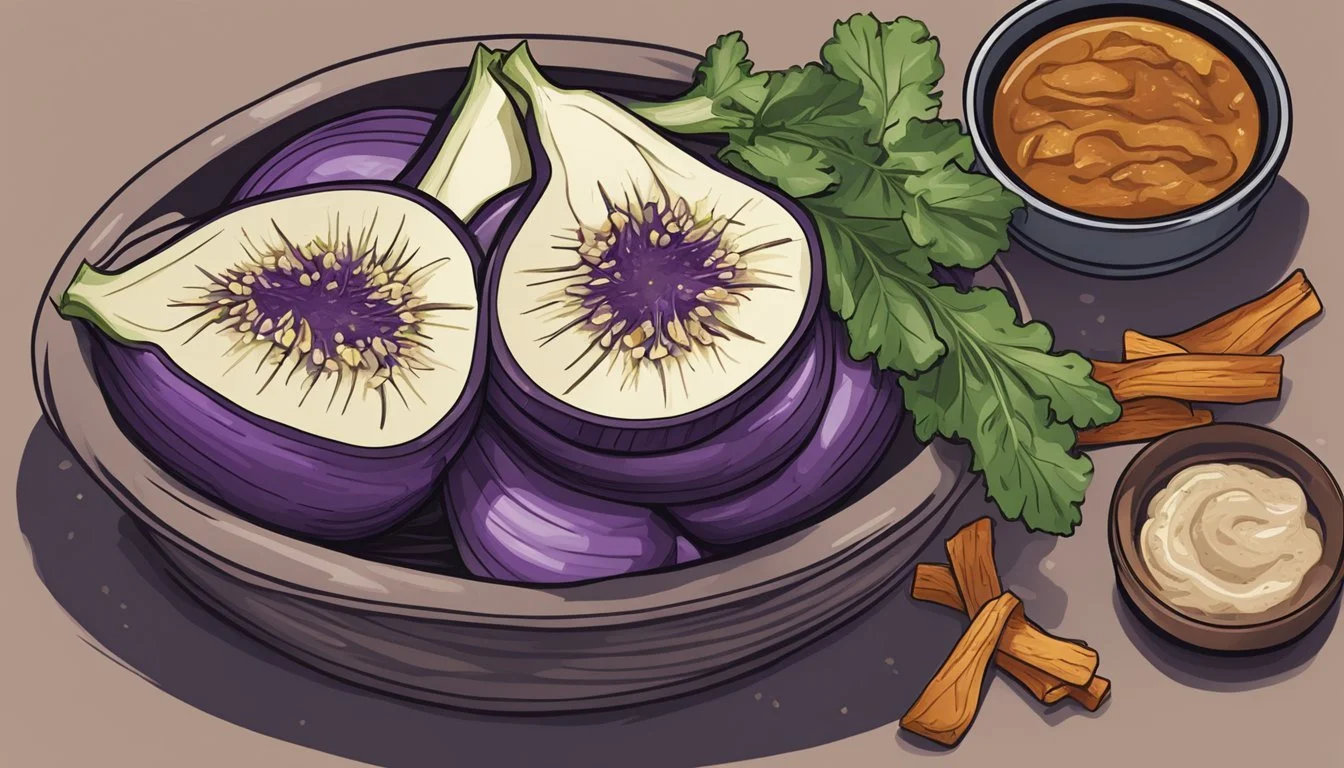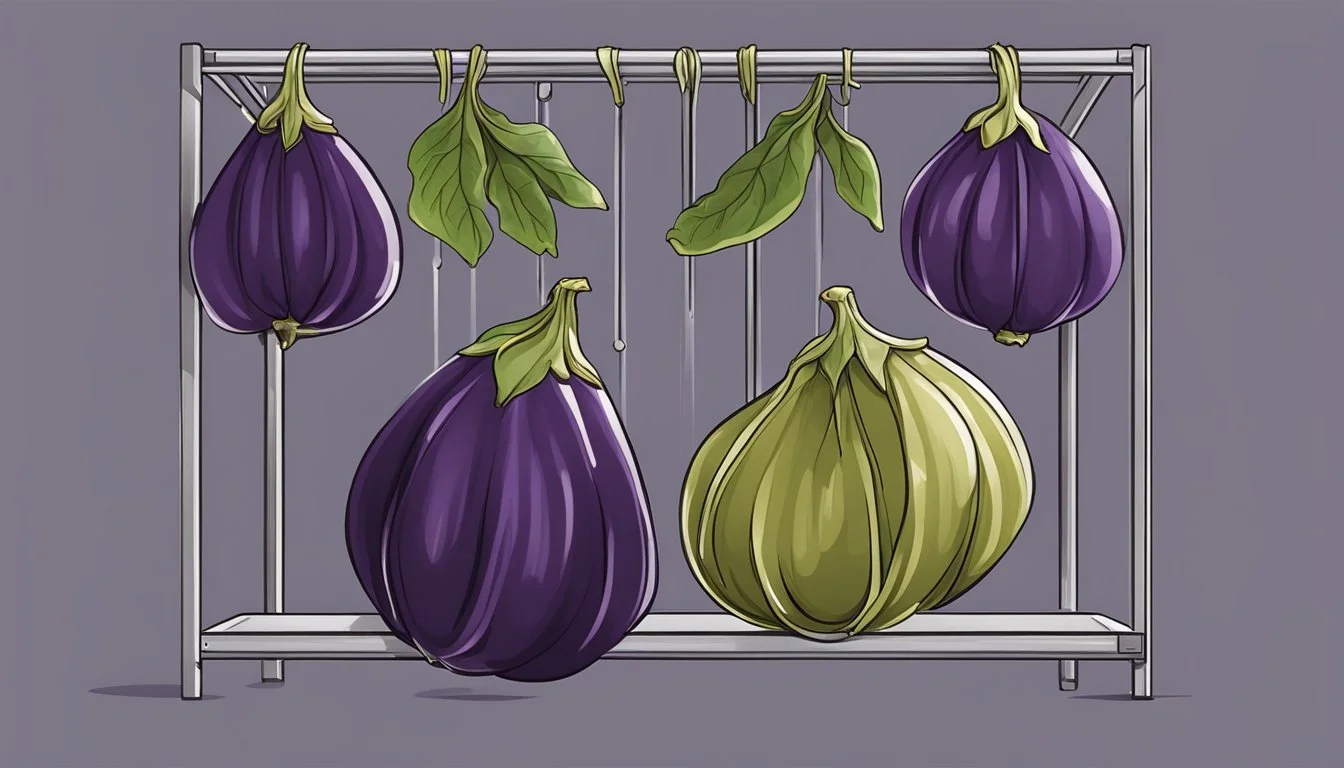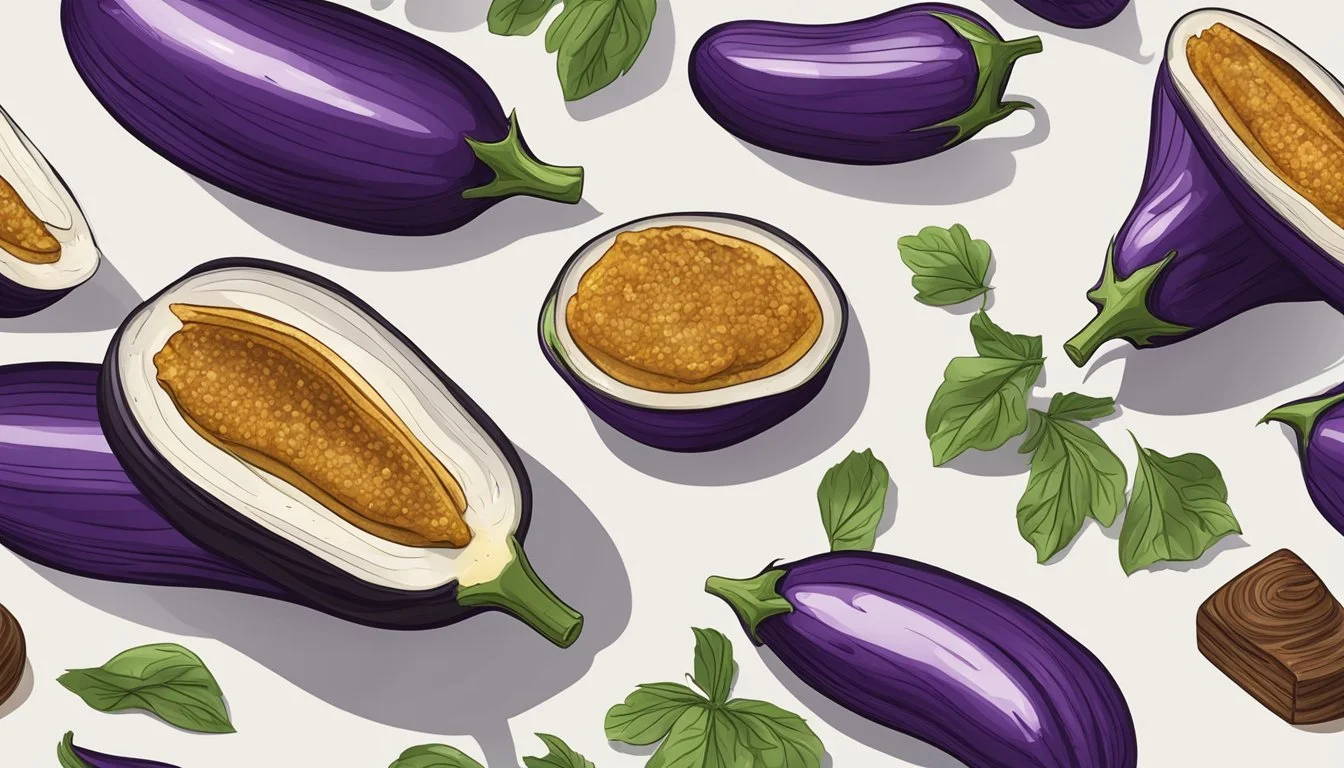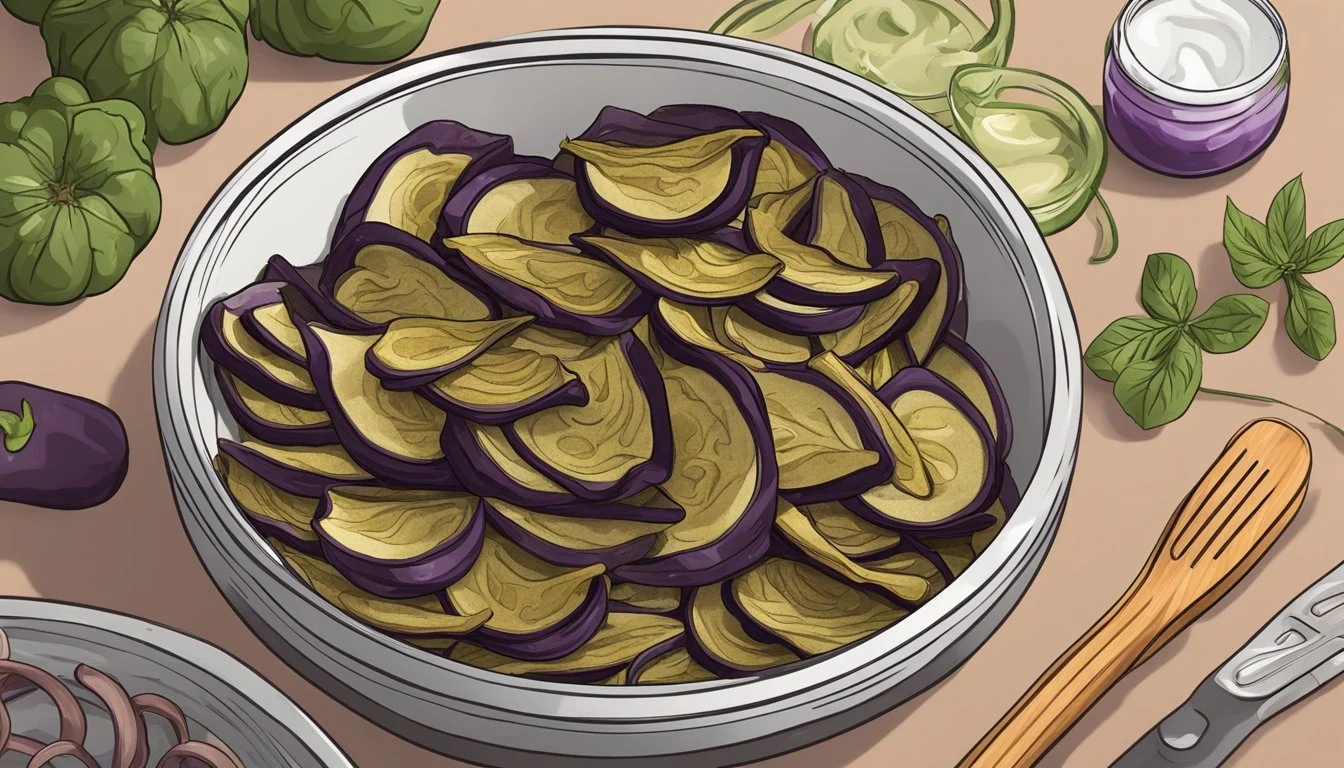Eggplant Peel Jerky
A Chewy, Smoky Snack Revolution
Eggplant jerky emerges as an innovative snack that is gaining popularity for its unique texture and flavor profile. It offers vegans and health-conscious individuals a plant-based snack alternative that provides the chewy and smoky satisfaction traditionally associated with meat jerky. Made from thinly sliced eggplant, this snack is marinated in a blend of savory seasonings before being dehydrated to achieve the desired chewiness. Its preparation is straightforward and adaptable, allowing for a variety of seasoning combinations to suit individual taste preferences.
The versatility of eggplant makes it an excellent candidate for jerky. The subtle flavor of the fruit—an eggplant (What wine goes well with eggplant?) is botanically a fruit, though often considered a vegetable in the culinary world—acts as a canvas for a myriad of flavors, from classic smoky barbecue to spicy or sweet teriyaki. Moreover, eggplant's texture after dehydration mimics the chewy bite of traditional jerky, making it a satisfying snack for anyone seeking a meatless option.
Creating eggplant jerky is not only a way to enjoy a delicious vegan snack but also a method to reduce food waste, as even the peel can be utilized during the process. This approach aligns with a growing trend of environmentally conscious consumption, where more consumers are seeking out snacks (What wine goes well with snacks?) that are not only tasty and nutritious but also have a lower impact on the planet. Eggplant jerky crafts an opportunity for snack enthusiasts to explore the savory world of plant-based alternatives without compromising on flavor or experience.
History and Popularity
Before eggplant jerky became a contemporary plant-based snack, jerky itself has a long-standing history, especially as a favorite in Texas. While traditionally jerky is made from beef and serves as a durable, protein-dense food, eggplant jerky is a modern twist, adopting the same preservation method.
Jerky originated as a means to preserve meat. Before refrigeration, people dried meat to extend its shelf life. This practice has been documented globally, from ancient Egypt to the indigenous tribes of North America. In Texas, beef jerky has been notably popular, evolving into a multi-billion-dollar industry, indicative of not only its taste but its convenience as a snack.
Eggplant jerky mirrors the textural and flavor profiles of traditional jerky but caters to those seeking plant-based alternatives. It's recognized for its chewy texture and can be flavor-enhanced through marination and smoking, much like its meat counterpart.
The popularity criteria for eggplant jerky reveal:
A significant decrease in popularity by -62.96% over the past year.
On average, consumed once annually.
Undetectable presence in restaurant menus and recipes, with 0% market adoption.
Despite these figures, the market for alternative snacks like eggplant jerky suggests a niche but growing interest, driven by dietary preferences and sustainability considerations. The versatility allows this snack to be customized and enjoyed in various flavors, thereby giving it potential for growth among food enthusiasts who favor plant-based options.
Health Benefits
Eggplant peel jerky stands out as a nutritious snack option, particularly for those adhering to vegan and gluten-free diets. Eggplants, being the focal ingredient, are a rich source of vitamins, minerals, and dietary fiber, making this snack both filling and beneficial for overall health.
Nutritional Profile:
Fiber: Aids in digestion and can promote a feeling of fullness.
Vitamins: Includes vitamin C, vitamin K, and B vitamins for energy metabolism.
Minerals: Provides potassium, manganese, and folate.
The snack fits seamlessly into a vegan diet, offering a plant-based source of nutrients and an alternative to traditional meat jerky. The chewy texture and smoky flavor of eggplant peel jerky are crafted to satisfy cravings without the use of animal products.
Additionally, for individuals with gluten sensitivities, eggplant peel jerky is a naturally gluten-free option. It provides a safe choice for those looking to indulge in a chewy snack without the gluten found in many other processed snacks.
The preparation process typically involves marinating slices of eggplant in various spices and herbs, enhancing both the flavor and the health properties without adding gluten-containing ingredients. It's important to ensure that all added spices and condiments are also gluten-free to maintain the integrity of the snack.
Overall Nutrient Value:
Low in calories
No cholesterol
Negligible saturated fat
Antioxidant properties from plant compounds
Eggplant peel jerky combines taste with health-conscious considerations, making it an appealing option for health-focused snackers.
Selecting Ingredients
The success of eggplant jerky hinges on the selection of fresh, high-quality produce and spices. Selecting the finest eggplant and complementary seasonings ensures a flavor-packed jerky with an ideal chewy texture.
Choosing the Right Eggplant
When choosing eggplants for jerky, one should look for firm, glossy fruits that are heavy for their size. The skin should be smooth without dents or discolorations. Italian eggplants are favored for their dense, meaty texture, which translates into a chewy jerky.
Sourcing Quality Spices and Seasonings
For the spices and seasonings, sourcing high-quality ingredients is key to achieving the desired flavor profile. Traditional spices such as olive oil, paprika, and black pepper should be fresh for the best taste. For a smoky kick, one might consider smoked paprika or a dash of cayenne. Chili powder can add depth, while a pinch of oregano brings a subtle herby touch. Always taste spices before use to ensure their potency and quality.
Olive Oil: A staple for marinades, provides a flavorful base.
Paprika & Smoked Paprika: Adds color and a nuanced sweetness with a smoky undertone.
Black Pepper: Essential for a spicy kick.
Cayenne: Use sparingly to introduce heat without overpowering.
Chili Powder: Melds warmth and complexity.
Oregano: Offers a hint of earthiness.
Preparation Techniques
The creation of eggplant peel jerky hinges on two pivotal steps: the meticulous preparation of the eggplant and the crafting of a flavorful marinade that imbues the slices with a rich, smoky essence. Perfecting these techniques will result in a delicious, chewy snack.
Preparing the Eggplant
One begins by selecting firm, fresh eggplants to ensure the final jerky has the desired texture. The eggplant should be washed and then sliced uniformly to promote even dehydration. Slices should ideally be around 1/4 inch thick. Before seasoning, it is common practice to sprinkle the slices with salt, which not only enhances flavor but also aids in drawing out excess moisture. Following the salting, one should lay the slices on wire racks without touching to maximize air circulation.
Creating the Marinade
The marinade is a blend of ingredients that often includes soy sauce, balsamic vinegar or apple cider vinegar, and garlic. Sweeteners such as honey or pure maple syrup can be added along with liquid smoke for a deeper smoky profile. All ingredients are whisked until well combined. The eggplant slices are then immersed in the marinade, ensuring each piece is evenly coated. For best results, the marinated slices should rest for at least two hours, which not only allows the flavors to penetrate but also tenderizes the slices before dehydration.
Dehydration Process
The dehydration process is crucial for creating eggplant peel jerky, focusing on methods using either a dehydrator or an oven to achieve the desired chewy, smoky texture.
Using a Dehydrator
Preparation: Begin by ensuring the sliced eggplant peels are arranged in a single layer on dehydrator trays lined with parchment paper. Leave about a 1/2 inch of space between slices to allow for proper air circulation.
Dehydration: Set the dehydrator to a temperature of 115 degrees Fahrenheit. This low temperature is ideal for slowly extracting moisture without cooking the eggplant.
Cook Time: Expect to dry the eggplant peels for 12 to 18 hours, checking periodically for the desired dryness and texture. Peels should be dehydrated until they're completely dry yet still pliable.
Using an Oven
Rack and Sheet Setup: Place a wire rack on top of a rimmed baking sheet to ensure even air flow around the eggplant slices.
Temperature: Preheat the oven to 175 degrees Fahrenheit, which is the optimal temperature for oven dehydration.
Cook Time: Lay the eggplant slices on the prepared rack, and allow them to dehydrate in the oven for 2 to 3 hours. Check the peels occasionally, looking for edges that start to crisp.
Total Time: Depending on the oven and thickness of the slices, total dehydration time may vary, but slices generally become dry to the touch and chewy within 4 to 6 hours.
Throughout the process whether using a dehydrator or oven, it's key to maintain a consistent temperature and to check the eggplant periodically to ensure it does not over-dry. The end goal is a jerky that is dry to the touch, chewy, and infused with a concentrated, smoky flavor.
Post-Dehydration Steps
After the dehydration process, eggplant jerky reaches its ideal chewy and crispy texture. The following steps ensure the jerky is properly finished for storage and consumption, transforming it into a satisfying snack.
Cooling and Curing
Once the dehydration is complete, the eggplant jerky should be transferred from the dehydrator or oven to a cooling rack. It's crucial that each piece is separated to prevent sticking and to allow for even air circulation. The jerky should rest until it is completely cooled, which may take approximately 30 minutes to an hour. This resting period, also known as curing, is important as it helps to even out any remaining moisture and ensures the jerky acquires a uniform texture that is both chewy and somewhat crispy.
Slicing and Serving
The cooled eggplant jerky can then be cut into smaller, bite-sized pieces if desired. For a fun and flavorful snack, one can serve the jerky with dips such as hummus or nut butter, pairing the smokiness of the jerky with the creamy texture of the dips. When serving, it's important to consider the level of chewiness and crispness of the jerky to ensure it complements the selected accompaniments.
Storage and Preservation
Proper storage is crucial in maintaining the freshness and extending the shelf life of eggplant jerky. Once the jerky is dry to the touch and has a chewy texture, one should ensure it is cooled completely before packaging. This minimizes the risk of condensation, which can lead to spoilage.
For short-term storage, placing the jerky in an airtight container is sufficient. A resealable plastic bag, preferably a thick, food-grade Ziplock bag, is good for this purpose. The air should be pressed out of the bag to prevent moisture from affecting the jerky.
For long-term storage, one can use a vacuum sealer to remove all air before sealing. This method significantly extends the jerky's shelf life by minimizing oxidation and moisture exposure. Store the vacuum-sealed bags in a cool, dark place.
Moreover, using a food dehydrator can be beneficial for achieving an optimal dryness level before storage. This device ensures even drying and can deliver a consistent chewy texture throughout the jerky pieces.
When stored properly, eggplant jerky can preserve its quality for several weeks. It's recommended to perform a quick visual and olfactory check before consumption, especially if stored for longer periods.
Key Storage Tips:
Cool jerky completely before packaging.
Use airtight containers or quality resealable bags.
Press out excess air to prevent moisture.
Consider a vacuum sealer for extended storage.
Store in a cool, dark place to maintain quality.
Regular checks before consumption are advised.
Serving Suggestions and Pairings
Eggplant peel jerky emerges as a versatile snack, offering both an appealing chewiness and a smoky flavor. Here are various ways to enjoy this unique treat:
By Itself:
As a standalone snack, eggplant jerky is a satisfying option. It packs easily for on-the-go snacking and provides a healthier alternative to traditional chips or processed snacks.
With Dips:
For those who appreciate a burst of flavor, consider pairing eggplant jerky with a variety of dips. It holds up well to thicker dips, like hummus or a yogurt-based tzatziki.
Bold-flavored dips to consider:
Spicy salsa
Rich, creamy blue cheese
Smoky baba ganoush
As Part of a Platter:
Integrate eggplant jerky into a charcuterie board for a vegetarian touch. Its chewy texture contrasts nicely with soft cheeses and crisp crackers.
Recommended platter components:
An assortment of cheeses (e.g., cheddar, goat cheese, brie)
A variety of crackers and sliced baguette
Fresh grapes and apple slices for a sweet note
In Dessert:
The unconventional idea of merging eggplant jerky into the dessert category can intrigue the palate, especially when included in a deconstructed dessert platter.
Dessert pairings to explore:
Dark chocolate pieces
Dried fruits, such as apricots or figs
Nuts such as almonds or walnuts
Eggplant peel jerky can be creatively served, and it boldly complements an array of dishes from savory to sweet. It lends itself well to various culinary settings, fitting seamlessly from casual snacking to an elegant appetizer spread.
Customization and Variations
When creating eggplant jerky, the versatility of the recipe allows for a variety of seasonings and marinating techniques to enhance the flavor profile. Here are some customization options one can consider:
Marinating Time
Short Marination: 2+ hours for a subtle taste.
Long Marination: Overnight for deeper flavor infusion.
Seasoning Variations
Seasonings Taste Profile Red Pepper Flakes Adds a spicy kick Smoked Paprika Provides a smoky essence. Garlic Powder Infuses a pungent aroma
The seasonings can be adjusted according to one's personal taste preferences. Marinating the eggplant in a concoction of chosen seasonings allows the flavors to seep into it, creating a more intense experience upon consumption.
Method Variations
Oven-Drying: Traditional and steady, with eggplant slices laid out and dried for 4-6 hours.
Air Frying: Quicker and with a unique texture, pay careful attention to timing to avoid over-drying.
Herbs and Spices: One can also experiment with various herbs and spices. A dash of thyme or oregano can add a Mediterranean twist, while a sprinkle of cumin could lend an earthy warmth to the jerky.
Remember, the key to a great eggplant jerky lies in the balance of flavors and the dryness of the finished product—it should be dry to the touch and chewy, but not brittle. These variations can help one achieve a jerky that caters to their flavor preferences while maintaining the snack's unique, satisfying chew.
Gardening Tips for Eggplant
When planting eggplant in a garden, soil preparation is crucial. They prefer well-drained soil with a pH level of 5.5 to 6.5, which means it should be slightly acidic. Before planting, one should enrich the soil with compost or aged manure, providing the nutrients the eggplants need for growth.
Starting eggplants from seed should be done six to nine weeks before the last frost date. They require warm soil temperatures, ideally between 75-85°F (24-29°C). Gardeners may use black plastic mulch to warm the soil if needed.
Here's a brief guide on eggplant care:
Stage Care Instructions Sowing Start indoors in trays. Use peat pots to minimize root disturbance when transplanting. Transplanting Space plants 24-36 inches apart. Plant in a sunny spot after all danger of frost has passed. Watering Provide 1 to 1.5 inches of water per week. More if the weather is very hot or windy. Fertilizing Use a balanced fertilizer every two weeks once fruit sets. Pest Management Check for and manage pests like aphids and spider mites. Use natural or suitable pesticides.
Regular watering is important; however, they should be watered at the base, avoiding wetting the leaves to prevent disease. When the first fruits are about the size of a quarter, fertilize the plants with a balanced fertilizer to encourage growth. Pest control is also necessary for gardeners to ensure the plants are not overwhelmed by common pests such as aphids and spider mites.
By following these tips, one increases the chances of a bountiful eggplant harvest, perfect for a variety of snacks such as eggplant jerky.
Recipes Featuring Eggplant Jerky
Eggplant jerky has emerged as a popular snack for both vegetarians and meat-eaters alike. This versatile treat can be incorporated into a variety of recipes, turning the humble eggplant into a chewy, smoky flavor boost.
Eggplant Jerky Salad Topping
They can shred eggplant jerky into pieces and sprinkle it on top of a fresh garden salad to add a new texture and smoky flavor. Consider combining mixed greens, cherry tomatoes, cucumber slices, and a tangy balsamic vinaigrette with the jerky for a nutritious and satisfying meal.
Ingredients Quantity Preparation Mixed greens 2 cups Washed and dried Cherry tomatoes 1/2 cup Halved Cucumber 1/2 cup Sliced Eggplant jerky 1/4 cup Shredded Balsamic dressing To taste Drizzled
Eggplant Jerky Wrap
For a more substantial option, they can incorporate eggplant jerky into wraps. Use a whole wheat tortilla, add lettuce, tomatoes, shredded carrots, cucumber, and pieces of eggplant jerky for a satisfying crunch. A spread of hummus or Greek yogurt adds creaminess and binds all the flavors together.
Eggplant Bacon Substitute
Eggplant jerky can also serve as an alternative to bacon. Prepare it with a blend of spices that mimic the smokiness and umami of bacon, and add it to sandwiches, breakfast dishes, or anywhere bacon is typically used. By cutting the eggplant into thin slices before dehydrating, they will achieve a bacon-like texture that pairs wonderfully with eggs or can be crumbled over soups and salads.
Eggplant Jerky and Avocado Toast
Another simple yet delightful recipe is avocado toast with a twist. Spread ripe avocado on toasted whole-grain bread and top it with strips of eggplant jerky. The contrast between the creamy avocado and the chewy jerky makes for an engaging and flavorful experience.
Frequently Asked Questions
What is eggplant peel jerky?
Eggplant peel jerky is a snack made by dehydrating strips of eggplant skin until they acquire a chewy, jerky-like texture. It offers a smoky flavor that can be enhanced with seasonings and marinades.
How do you make eggplant peel jerky?
The process involves slicing eggplant into even strips, marinating if desired, and then dehydrating in an oven or dehydrator at a low temperature, typically between 175°F to 200°F, for several hours until chewy.
Is peeling the eggplant necessary?
For peel jerky, using just the skin is customary for a consistent texture and concentrate the flavor. Meanwhile, the flesh can be used elsewhere to reduce waste.
How long does it take to dehydrate eggplant peels?
Typically, dehydration takes around 2 to 6 hours, depending on peel thickness and oven or dehydrator efficiency. Peels are ready when they are dry to the touch and pliable.
Can you flavor the jerky?
Absolutely. Before dehydrating, eggplant peels can be marinated in mixtures containing ingredients such as soy sauce, smoked paprika, or liquid smoke for added flavor.
How do you store eggplant peel jerky?
Store it in an airtight container in a cool, dark place. It should last for a couple of weeks, but ensure it's completely dehydrated to prevent spoilage.
Is eggplant jerky healthy?
Eggplant peel jerky is low in calories and contains some nutrients and fiber. However, the nutritional content can vary depending on the added ingredients.
Conclusion
Eggplant peel jerky offers a unique and flavorful plant-based alternative to traditional meat jerky. Through slow baking or dehydrating, eggplant peels transform into a chewy and smoky snack that is not only delicious but also wastes less food by utilizing the peels.
Those looking for a healthier snacking option can appreciate its relatively simple preparation and the capacity for personalization with various marinades and seasonings. As with any jerky, the thinness of the slices and proper drying time are crucial, aiming for that perfect balance of chewiness without moisture that leads to spoilage.
Advantages of eggplant peel jerky include:
Sustainability: Utilizing the peels reduces food waste.
Versatility: Flavors can be adjusted to suit individual tastes.
Nutrition: Eggplants are a good source of dietary fiber and nutrients.
Eggplant peel jerky can be seen as more than a snack — it embodies a creative and responsible approach to cooking, showing that with a bit of ingenuity, even scraps can be transformed into something enjoyable and eco-friendly. It encourages consumers to think outside the box and explore the potential of all parts of their food.
When made correctly, eggplant peel jerky is not just a treat for the palate but also a testament to the endless possibilities of plant-based cuisine.











